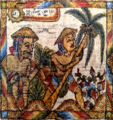Kelapa Sunda: Difference between revisions
(stellarium painting) |
(HIPs) |
||
| Line 57: | Line 57: | ||
* {{NAMESPACE}} |
* {{NAMESPACE}} |
||
== All HIP Stars within this constellation == |
|||
{| class="wikitable" |
|||
|+ |
|||
!DEmax |
|||
!DEmin |
|||
!RAmax |
|||
!RAmin |
|||
!area / °² |
|||
!total number of stars |
|||
|- |
|||
| -19.80539 |
|||
| -34.29323159 |
|||
| -239.221155 |
|||
| -252.5408784 |
|||
| |
|||
|28 |
|||
|} |
|||
HIP 78104, HIP 78265, HIP 78401, HIP 78575, HIP 78650, HIP 78699, HIP 78820, HIP 78877, HIP 78933, HIP 78990, HIP 79031, HIP 79050, HIP 79098, HIP 79302, HIP 79399, HIP 79404, HIP 79530, HIP 79622, HIP 79881, HIP 79980, HIP 80079, HIP 80112, HIP 80399, HIP 80763, HIP 81266, HIP 81741, HIP 81891, HIP 82396 |
|||
== References == |
== References == |
||
Latest revision as of 04:32, 10 October 2025
Kělapa Sunda is an Oceanic name from Bali (Indonesia). The lintang of kělapa sunda is found in intersection of Coma (Monday, in saptawara) and Umanis (in pancawara) in a series of palelintangan. Lintang kělapa sunda means a leaning coconut tree constellation.[1]
Etymology and History
This constellation term is consisted of two words, “kělapa” (IPA: /kəˈla.pa/) and “sunda” (IPA: /ˈsundɑ/).
Spelling Variants
- kalapa sundě
- n’ju
- klapa dojong
- kělapa
- kala cindě
- kělapa sondo
- pohon kělapa
Origin of Constellation
Kelapa is coconut while sunda or dojong is leaning. Kelapa sunda means a leaning coconut tree. Coconut is a local plant in Bali. Bali holds the history of coconut tree vegetation, especially in the Nyuhtebel area, which is written in the Gelgel Kingdom inscription about the mission of the Gelgel Kingdom troops on the orders of the Gelgel King in 1465 CE, Dalem Batur Enggong Kresna Kepakisan, to paralyze the power and take over the power of De Dukuh Mengku Tenganan because he did not submit to the power of the Gelgel Kingdom.[2]
Coconut is a multi-purpose tree and all parts of the coconut can be used. In Bali, parts of the coconut tree are widely used for religious events, construction, and raw materials for food and drinks. Parts of the coconut in Balinese:[3]
- Coconut fruit is called nyuh
- Young coconut fruit is called kuud
- Young coconut leaves are called busung, usually used to make Balinese jejaitan
- Old coconut leaves are called slepan
- Dry coconut leaves are usually called danyuh
- Unblown coconut flowers are called tongtongan
- Unblown coconut flowers that will turn into fruit are called bungsil
- Dried flowers are usually called kloping
- The tip of the coconut tree is called empol
- The trunk of the coconut tree is called seseh
Transfer and Transformation of the Constellation
Mythology / Religion
There is a myth that has developed regarding the existence of coconut trees. Taken from the UTS Sivasiddhanta II quote (the meaning of the banten(offerings) and its mantra) it is told as follows, starting from the story of the God Brahma who has four heads, Catur Muka. At that time, God Shiva released an arrow to cut off one of the five heads of God Brahma so that God Brahma had four heads, so God Brahma was called Pala Dewa Catur Mukha. The severed head of God Brahma fell to the world and caused a very powerful earthquake. Seeing the world shaking violently, God Shiva took it and threw it into the sea. However, the sea also became shaken, the sea water rose and hit the coast. Finally, the head of God Brahma was taken again by God Shiva and planted on the beach. Then over time, the head of God Brahma that was planted grew into a coconut. That was when the coconut tree first appeared and until now it plays a very important role in organizing the Yajna ceremony of the Hindu Dharma community.[4]
Image Variants
Cultural Beliefs
Numerology (Neptu/Urip)
Coma (Monday, in saptawara) has a value of 4 and Umanis (in pancawara) has a value of 5. Thus, the total urip on this lintang is 9.[5]
Astrological Characteristics
Can be rich if they try in the field of seeding, agriculture, plantations. All their work finds good results. They are polite, friendly to everyone, unfortunately like to interfere in other people's affairs, and have a curious nature and are too curious.[5]
Matching Gemstones
Kecubung (amethyst), Cempaka (yellow sapphire).[5]
Weblinks
All HIP Stars within this constellation
| DEmax | DEmin | RAmax | RAmin | area / °² | total number of stars |
|---|---|---|---|---|---|
| -19.80539 | -34.29323159 | -239.221155 | -252.5408784 | 28 |
HIP 78104, HIP 78265, HIP 78401, HIP 78575, HIP 78650, HIP 78699, HIP 78820, HIP 78877, HIP 78933, HIP 78990, HIP 79031, HIP 79050, HIP 79098, HIP 79302, HIP 79399, HIP 79404, HIP 79530, HIP 79622, HIP 79881, HIP 79980, HIP 80079, HIP 80112, HIP 80399, HIP 80763, HIP 81266, HIP 81741, HIP 81891, HIP 82396
References
- References (general)
- ↑ Maass, Alfred, “Astrologische Kalender der Balinesen,” in Koninklijk Bataviaasch Genootschap van Kunsten en Wetenschappen, Feestbundel bij gelegenheid van zijn 150 jarig bestaan 1778-1928, 2 vols. (Weltevreden, 1929), Vol. 2, 126-157.
- ↑ Anggraeni, Vita Ayu, "Jejak Nyuh, Pohon Kehidupan di Pesisir Bali Timur," (2018) https://www.goodnewsfromindonesia.id/2018/08/21/jejak-nyuh-pohon-kehidupan-di-pesisir-bali-timur
- ↑ Trisna, "Ada Banyak Sebutan, Ini 10 Nama Bagian Pohon Kelapa dalam Bahasa Bali," (2020) https://www.idntimes.com/life/education/ada-banyak-sebutan-ini-10-nama-bagian-pohon-kelapa-dalam-bahasa-bali-c1c2-1-01-ghggl-np300k
- ↑ Bali Factual News, "Kelapa Dalam Filosofi Umat Hindu," (2019) https://balifactualnews.com/kelapa-dalam-filosofi-umat-hindu/
- ↑ 5.0 5.1 5.2 Tim Kajian Palelintangan, “Gabungan Kajian Palelintangan,” Museum Bali (2021), 1-149.







